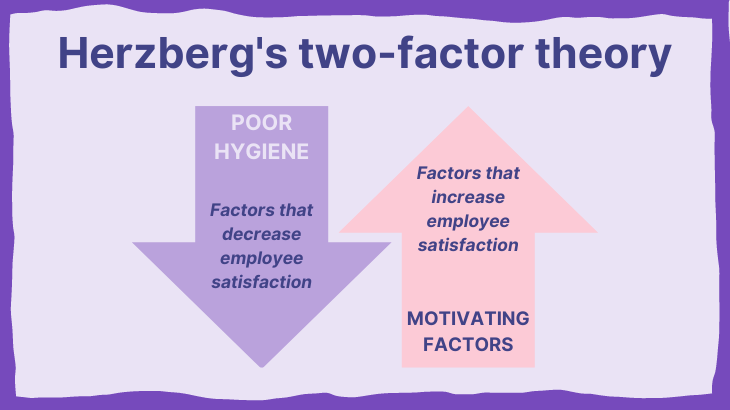We’re all familiar with the concept of opposites. If something is heavy, it can’t also be light. If something is quick, it can’t also be slow. If you’re satisfied with something, you can’t also be dissatisfied with it.
But what if that isn’t always the case?
When it comes to job satisfaction, can you be both satisfied and dissatisfied at the same time? That’s exactly what Herzberg’s two-factor theory of hygiene and motivation aims to address.
Table of contents
What is Herzberg’s two-factor theory?
Frederick Herzberg was an American psychologist who introduced his theory of job satisfaction in the mid-1960s, which led to the 1968 publication, “One More Time, How Do You Motivate Employees?,” which has gone on to sell millions of copies.
The two-factor theory, also known as Herzberg’s motivation-hygiene theory, supposes that when it comes to our work lives, there are different, mutually exclusive factors that contribute to our ultimate feelings of job satisfaction or dissatisfaction:
- Hygiene factors — The context in which the role is performed. This could be anything from your desk or office, to the company policies and pay structure. Hygiene factors, when not addressed satisfactorily, can lead to unpleasant working conditions
- Motivation factors — Elements that are intrinsic to the role itself. This could be anything from how interesting or engaging the work is, to the opportunities for career development or personal growth. Motivation factors contribute to employees’ productivity, creativity, commitment, and sense of achievement
The theory goes on to propose that it is possible for an employee to be satisfied with one set of factors relating to their role whilst simultaneously being dissatisfied with another set of factors. The potential for this mismatch of satisfaction can have wide-ranging effects on both the employee and the employer.
Two-factor theory examples
How can you use the two-factor theory within the workplace to improve the overall satisfaction of your team? To some degree, it depends on the kind of work that you’re doing.
Store cashier
For example, if you’re running a corner store and you hire a cashier to work for you over the weekends, some elements of the theory are more applicable than others.
The cashier role may not provide the same degree of personal growth or career development as other roles. However, it is still important to address the hygiene factors, such as providing a clean and safe working environment, offering fair pay, and having clear policies in place.
Software development
On the other hand, if you’re running a software development team, both hygiene and motivation factors will play a significant role in employee satisfaction.
In this case, you should address hygiene factors, such as providing a pleasant working environment and competitive pay, but also focus on motivation factors, such as challenging projects, opportunities for professional growth, and recognition for achievements.
Product management
When looking to improve job satisfaction within a product team, it is crucial to pay attention to both hygiene and motivation factors. Here are some practical steps you can take:
- Address hygiene factors — Ensure that the working environment is comfortable, offer competitive salaries and benefits, and establish clear company policies and procedures. This will help to minimize dissatisfaction caused by external factors
- Promote motivation factors — Foster a sense of achievement by setting challenging goals and providing opportunities for professional growth. Recognize and reward employees’ achievements and give them autonomy in their work
- Encourage open communication — Maintain an open dialogue with team members to identify any issues they may be experiencing and address them promptly. This will help to prevent dissatisfaction from festering and negatively impacting the team’s overall satisfaction
Keeping an open dialogue
One of the most effective ways to apply Herzberg’s two-factor theory in the workplace is to maintain open and honest communication with your team members. By encouraging feedback and addressing concerns as they arise, you can create a more satisfying work environment that will ultimately lead to increased job satisfaction and improved team performance.
Here are some strategies for product managers to promote open dialogue:
- Create a feedback-friendly environment — Encourage team members to share their thoughts and concerns regularly, both in formal settings like team meetings and informal conversations. This will help establish trust and create a culture where employees feel comfortable speaking up
- Actively listen and show empathy — When team members share their feedback, listen actively and empathize with their concerns
- Ask open-ended questions — Encourage in-depth discussions by asking open-ended questions that allow team members to express their thoughts and feelings. This can help uncover underlying issues that might not have been apparent otherwise
- Address concerns promptly — When issues are brought to your attention, take swift action to address them. Take every opportunity to demonstrate to your team that you’re dedicated to creating a satisfying work environment
- Regularly check-in with team members — Schedule regular one-on-one meetings with each team member to discuss their progress, goals, and any concerns they may have
Conclusion
Understanding and applying Herzberg’s two-factor theory can be an effective way to boost job satisfaction within your team. Addressing both hygiene and motivation factors and keeping an open dialogue with your team members enables you to create a positive work environment that promotes employee satisfaction and leads to a more productive and successful team.
Featured image source: IconScout
The post Herzberg’s two-factor theory of motivation-hygiene: An overview appeared first on LogRocket Blog.
from LogRocket Blog https://ift.tt/MrXyHWc
Gain $200 in a week
via Read more




